TV Dinners: Child Stars Garnish Recipes With Recollections
Barry and Stanley Livingston “chow down” in TV Dinners. (screenshot from My Three Sons)
If you grew up during the Golden Age of Television, chances are you can still recall Uncle Charlie barking at the Douglas boys “Now Hear This – Chow Down!” You’d probably also remember Lily Munster adding an assortment of odd ingredients to an ever-bubbling cauldron. Or how hopelessly divided the Lane cousins were between hot dogs and Crêpes Suzettes.
Food certainly played an important part in the lives of those beloved characters. But how on earth did any of those kids survive a steady diet of peas and carrots?
Author Laurie Jacobson gets to the meat of what it was like to be a child star, while compiling a freezer full of culinary delights in her new book, TV Dinners: 40 Classic TV Kid Stars Dish Up Favorite Recipes With a Side of Memories (2020 – TV Classics Press). We recently sat down with Laurie – on her birthday – to discuss her latest endeavor, from a safe social distance of some 2800 miles away.
BPE: Happy Earth Day and Happy Birthday!
Laurie: Thank you so much!
BPE: I don’t want to begin with an overreach here, but I understand you just recovered from a bout with the Coronavirus?
Laurie: Yes, I did.
BPE: Would you be okay with sharing a bit of that experience with our readers?
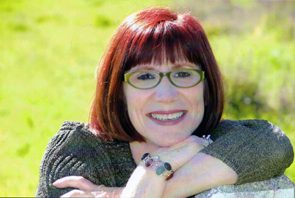
Laurie: I got it in March, right before the order to shelter in place. We were having a birthday party for my husband Jon (Provost), and we just decided to go ahead and have the party. As I said, it was early on, and someone at the party had the virus but did not start showing symptoms until the following day. Five days later, I was showing symptoms as well.I was able to get tested right away, and it was confirmed I had it.
I had a mild case, which was really lucky, because I have a chronic lung issue. I was very nervous about that, but it really didn’t settle in my lungs. Some people have more of a digestive issue, and that’s what happened to me. I had extreme loss of appetite; constant nausea. I had a temperature every day for 12 days and was just really, really fatigued.
BPE: Did Jon get it too?
Laurie: He did not get it. During the first week, when I was really bad, we were not isolating from one another, because we thought well, you know, what the heck? We slept in the same bed yesterday. But he, at that time, had the flu and he had a very productive cough with the flu. And our doctor thinks that’s what prevented him from getting it – that his lungs were lined with mucus and that prevented COVID-19 from settling into his lungs.
When she gave him antibiotics to fight his flu, she said you must isolate, so we did, and I never left the back bedroom. He used a different bathroom and a different bedroom and came in with a mask and gloves to leave a tray of food and left immediately. After my symptoms stopped, they asked me to stay in bed another two weeks to be sure I wasn’t still contagious. Given that we isolated within the same house, I am lucky that he didn’t get it.
BPE: So it was about a month-long thing?
Laurie: I was in bed for about three and a half weeks, yeah, almost four weeks. That has never happened to me before, and then coming back from that was a little more than I expected. I’d walk the dog and just be exhausted.
BPE: I guess the best news is that neither one of you got to the point where you were so sick that you had to send Lassie for help, right?
Laurie: (laughing) No, it didn’t!
BPE: Please tell our readers about Laurie Jacobson.
Laurie: I’m originally from St. Louis. I lived a couple years in Boston and in New York and loved it, then I moved out to LA in the mid-70s.
I was working as a stand up comic and in comedy improv, with undiscovered friends like John Ritter, Robin Williams and John Larroquette. This was before their big heydays, and that was just a wonderful time.
I always reveled in those who had come to Hollywood before me. That made me want to come there in the first place in the mid-70s.
First of all, a lot of those people from Hollywood’s Golden Age were still around. I mean, there were silent film stars that were still living and filled with incredible stories. There were also waitresses and maitre d’s around – people who had had their jobs for 30 or 40 years. The “pops” characters at the studio gate? They saw everything. The maitre d’s held their positions so long, because they knew who was dating who, who was no longer an item, and could say to themselves,“I’ve got to set these two people on opposite sides of the room, so they don’t see each other.”
You know, that’s how you kept your job for so long, and nobody had ever really thought to talk to them.
So that was a wonderful time to gather information about the Golden Age of Hollywood that I loved so much. And that’s what started me writing. After that, I’ve written several more books. I wrote for some television specials, and I wrote a lot of documentaries. I’m in a ton of documentaries, and I am considered a Hollywood historian and an expert in mayhem, mystery, murder and ghosts.
BPE: I guess it’s better to be considered a Hollywood historian than an artifact?
Laurie: (laughing) MUCH better!

BPE: Now of course, you’re married to Jon Provost of Lassie fame. He is certainly as recognizable a face as any of the child actors in the 50s and 60s, and still very well known and loved. Was meeting and being married to Jon what got you interested and involved with other child actors?
Laurie: Oh, absolutely. When I was a little girl in St. Louis and watching all these people on TV, of course, we were rather naive to how Hollywood worked back then. It didn’t even look like work to me. It was so easy to believe that they loved each other in their TV families, and indeed most of them did. But until I wrote Jon’s autobiography with him, I didn’t realize the responsibility these young kids carried on their shoulders. They showed up every day, they knew their lines, they knew their blocking; and if they didn’t, fifteen men were standing around on the set with nothing to do. Even if the children were sick, entire families depended upon them showing up and doing their job.
BPE: It’s interesting. I mean, you had this dual dynamic going on with shows like Make Room For Daddy and The Donna Reed Show that – while being very child actor dependent – were still primarily starring vehicles for Danny Thomas and Donna Reed. But that was juxtaposed with Leave it to Beaver and Lassie – to name just two – where the kids were the central figures in the show.
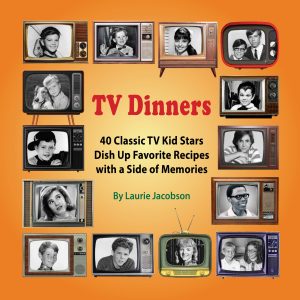
Laurie: Yes, absolutely. You know, Jon was in almost every scene, and there were not many other kids around – if any. The first year, he had a best friend, and after that they decided he didn’t need one.
For some of the kids, it was kind of lonely. I know when his contract ran out and they asked Jon to stay and do three more years, he was so ready to go out and meet girls!
BPE: Well, yeah, that does happen in the normal course of events with growing boys. How many child stars did you interview for this new book?
Laurie: I’d say 40. I might have had one or two more who came together. You know, like Stan and Barry Livingston and Angela and Veronica Cartwright, but I think I have 40.
BPE: I couldn’t help but notice in your press release a picture of Annette Funicello.
Laurie: Yes, there are two ladies that I absolutely had to include, whom I never met and who have passed away – Annette and Patty Duke.
To me, Annette is the queen of television child stars. Nobody quite like her and so beloved by her peers. And Patty Duke was it for me as a teen. Such a ball of talent. She was really remarkable, and I just adored her. So I wanted very much to include both of them.
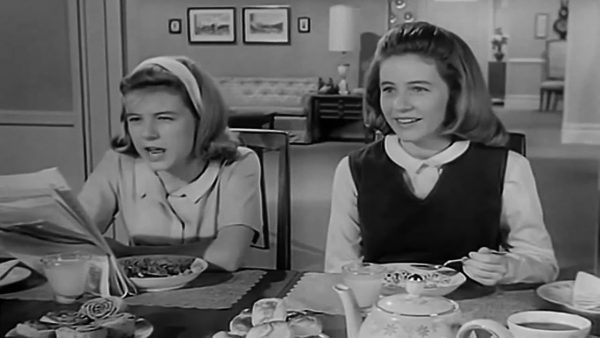
(opening credits screenshot from The Patty Duke Show)
BPE: I know when I spoke with Paul Peterson, I asked him about working with Shelley Fabares and the amount of fan mail that she got. Paul said the only person that got more fan mail than Shelley was Annette.
Laurie: Yeah, I posted some pictures of Annette on my TV Dinners Facebook page and about 5000 guys wrote in “my first crush.”
BPE: And with good reason. You mentioned your comedy and your writing, but in another professional aspect of your life, you professionally represent a lot of child stars. Did you interview anybody for this book who you didn’t previously know?
Laurie: That is a really great question. I’m looking over the list. I didn’t really know Sharon Baird, who was also a Mouseketeer. She was a very close friend of Annette’s. She’s also a very dear friend of Beverly Washburn, who is also in the book. That is how I came to her, and she was just a delight. And I had met Barry Williams from The Brady Bunch once or twice. I really didn’t know him very well, but I gave him a call and he was absolutely delightful.
BPE: I’ve always heard that Barry is as much the affable person in real life as what you saw on television.
Laurie: He was so generous; so sweet and so down to earth. And you know, that is really something that runs through this entire generation of kid stars.
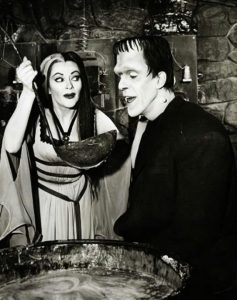
(Yvonne De Carlo and Fred Gwynne – press photo from The Munsters)
They were the first generation of kid stars to come into your home weekly. All of them were flying by the seat of their pants. They did not get the big salaries that kids got in later decades. But they got fan mail, and they got decently paid if their parents put it away for them. And in a time before the world was so small and so connected through social media, these kids were the connection for people.
Everyone knew, “What’s that, girl? Is Timmy in the well?” or “Hello, Mr. Wilson!”
They knew Will Robinson. You needed only to say those words to another baby boomer – a stranger – to be completely connected. We were all part of the peanut gallery, and we all had the same experiences watching them.
And these kids knew those phrases and characters too, even though often, they did not know each other.
Maybe they worked together; maybe they had photo ops together. But I really think it is through the autograph shows that started in the early 90s, where many of them finally got to talk to each other and form really lasting friendships. So one of the really sweet things about this generation is that they are all still friends.
BPE: I guess that’s an aspect that you don’t necessarily think about, unless you attend those nostalgia shows. And you can see that the camaraderie is palpable.
Laurie: Yes, absolutely. And so I have over 150 photos in the book of birthday parties from back in the heyday and dinner parties, where we all get together today. And I think that’s something that fans particularly enjoy.
You know, my husband did know Jay North as a child, and they attended a couple of schools together. It’s so great when he calls and Jon says, “Hey Jaybird!” That’s what he called Jay when he was seven; that will never go away. And it’s just very dear and very special to this generation of kids.
BPE: One thing that occurs to me here, I guess because I’m an old movie fan, is that even while there were some wonderful child actors in films of the 20s, 30s, and 40s, some of the kids who graced the big screen were pretty dreadful. I mean, for every Jackie Coogan or Shirley Temple, there were probably a dozen Bobs Watsons. I don’t mean to be a downer here, but halfway through Dodge City, you can’t wait for little Bobs to get killed. Yet, with the child stars in television, you really got the cream of the crop.
Laurie: Yes, yes, I agree. There was really a small group of child actors in TV in the early days, with perhaps 25 stars. And like I said, they were carrying a lot of responsibility. There’s nothing like working every day to get to professional really fast.
One thing that I learned writing this book was how many of them have actor parents, and some of them were with a single parent family. And that parent was an actor, and you know, there weren’t childcare facilities in the 50s and 60s, like there are now. So often, the kid went on the audition with mom or dad. And that’s how a lot of them got discovered.
Agents said “Wait a minute, I think your son is right for something I just read.” And boom – they were working kids! Suddenly, the adult’s career faded away with their child’s surprise stardom.
BPE: And sometimes financially to their benefit.
Laurie: Oh, yeah. Sure. And then, if the parent was on the set with the child, they got paid for that. You know, why pay a welfare worker? I know Jon’s mother received a salary for being on the set.
BPE: Do I recall this correctly from your book, that Jon’s mom was an actress?
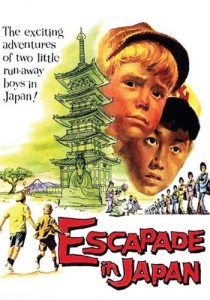
Laurie: I think she would have loved to have been, but no she didn’t do any acting. But boy, she really enjoyed Jon’s success. She had a lot of fun with it.
BPE: I love the story that you tell in the book about their trip to the far east.
Laurie: Oh, yes, for the film Escapade in Japan. That was the first American film production in Japan after World War II. So there were these two blonde people suddenly in the middle of Japan. I mean, you know, Jon was only six, but he remembers people running from all directions and reaching out to touch their hair. Public baths and sushi – everything was different.
BPE: Speaking of sushi, let me ask you a few TV Dinners-related questions here, because we could talk about old Hollywood forever. So many of the scenes from those classic TV shows were centered around the dinner table, with the family happily chowing down. Did this come up in any of the interviews you did? And if so, were there any TV meal horror stories?
Laurie: It didn’t really come up. I mean, Jon used to tell me stories of Lassie meals, but they didn’t have full kitchens on set like they do now. Everything was cold. Once you know that, then you learn what great actors they really were because they made that congealed stuff look delicious.
The only time it came up in the overall context of the book was with Alison Arngrim, who actually gave me a recipe for a dish that was on Little House on the Prairie. It was the centerpiece of an episode, where she played Nellie the bully, and she had invited Laura’s boyfriend over for dinner. But she couldn’t cook. So she forced Laura to make a dish that she could serve, which was called cinnamon chicken. But Laura substituted cayenne pepper for the cinnamon.
BPE: Ooh!
Laurie: Yeah. So Alison gave me that recipe. Spicy cinnamon chicken, because she still does use a little cayenne pepper on it, for taste. That is the only recipe in the book that actually came from a show.
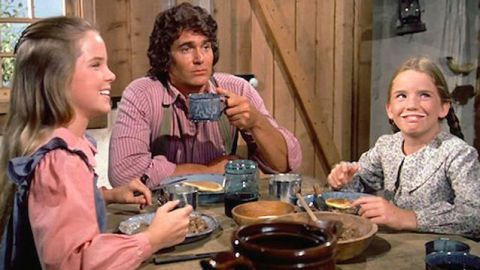
(screenshot from Little House on the Prairie)
BPE: Aside from their time on the set, these kids came up in an era where America’s eating habits were undergoing a seismic shift. Drive-ins, fast food, and so on. Did those cultural changes and teen hang-outs help to normalize their off-screen lives?
Laurie: Well, first of all, the reason I called it TV Dinners is because the television industry was growing so much at that time.
Families came together while watching TV.
Most homes only had one TV, so the memory of enjoying these shows was linked to enjoying them with your whole family. And often, that occurred during the dinner hour; so much so that Swanson actually invented something called a TV dinner.
Mom didn’t have to spend so much time in the kitchen. And then TV trays were invented to hold the TV dinners. The whole family could gather and watch their favorite show at dinnertime, which is an incredible phenomenon right there.
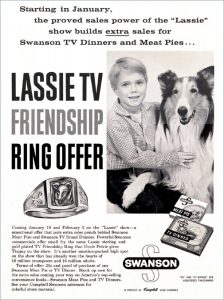
BPE: Indeed.
Laurie: Butch Patrick (Eddie Munster) had one of my favorite stories in the book about that. He said that his family was really not allowed to watch television during dinner time, except that the whole family had fallen in love with this new show called The Flintstones. Butch said his father would rush home after work to see it.
You know, this must sound crazy to people today, with all the things we have to tape shows now, but back then, if you missed it, you missed it. Butch recalled that his mom made tacos every Wednesday night. His father had a new Cadillac, and it barely fit in their garage. They’d hear dad’s bumper hit the back of the garage and – boom – it was time for The Flintstones.
So Butch has your basic television family watching memories – just like the rest of us had.
As for these kids driving, back in the 50s and 60s there was no food provided on the set. Doughnuts and coffee was pretty much the extent of it. Now they have these catering services, and everything you could think of is on the set. But back then, if you wanted to eat – you left.
And when they could drive and didn’t have to go with mom anymore, the hot dog stands and the soda shops and the ice cream parlors is where they went. Needless to say, there were tons of them all around the studios just for that purpose.
So you didn’t need to grow up in L.A. to know what they were talking about, because that’s what America was back in the 50s and 60s – drive ins and hot dog stands. It’s what we were all doing.
BPE: When the writers incorporated those places into Dobie Gillis or The Patty Duke Show, they were speaking to a public that could readily relate.
Laurie: Yes, absolutely.
BPE: Did any of the recipes that you were given surprise you?
Laurie: Some sounded inedible, when they were given to me, and I thought, “Are you kidding me?” But they would insist that they loved it and it was delicious at the time.
I remember Stan Livingston’s recipe was something he enjoyed as a child. They had a bunch of kids in their family, and the kids always had friends over. His mother invented something that sounded to me like such a hodgepodge. She’d throw it in a skillet and call it dinner. Stan insisted that it was everyone’s favorite, so I just went along with it.
BPE: You do know that Stan and Barry’s mother was from Baltimore? But that’s another story all its own.
Laurie: Yes, she certainly was quite a hottie.
BPE: Do you have a favorite recipe from the book?
Laurie: I have two recipes that I’m actually dying to try.

One came from Jeannie Russell, who was Margaret on Dennis the Menace. It is a carrot and cheese casserole that she said, every time she brings it to a party, she is always asked to bring it again. So that’s one I really want to try.
And Barry Livingston’s wife Karen makes something she calls a scallop cheese dish. Barry raved about it so much! He had Karen make it and he took photos and said, “You’ve got to see how beautiful it is as well as how delicious it is.” He was so enthusiastic about the dish that I thought “I’ve gotta make this too.”
I’m not the cook in my family, but Jon has just started reading the book, and he is marking up things he wants to try.
So many of the recipes are very simple, which I prefer. There are also a few that are quite complicated, I think.
Jon Walmsley from The Waltons has a trifle. He’s British and so are the Cartwright girls. They both have shepherd’s pie and baked pudding recipes. There’s some very upper-crust British stuff in there as well. A little something for everyone.
BPE: There we go. It’s a cookbook full of nostalgia.
Laurie: Absolutely. It’s a reunion with people that we grew up with. And as they discuss their memories of their time back in their heyday, you learn a lot about what it was like to be a working kid. And you learn a lot about their time with their families, plus some have really great culinary skills.
BPE: One final question here. Do you have any favorite TV mom making a meal or serving the family stories? Because I have one.
Laurie: Oh? Please tell me!
BPE: It’s from a very early episode of Lost in Space. You know, I’ve interviewed both Angela and Bill Mumy, and I don’t believe this came up in either interview. Anywho, in the story, the Robinsons have landed on a desolate planet, and they are about to run out of water. So Professor Robinson and Maj. West plan to set out to find a spring or dig a well – something like that.
Where it gets ridiculous is, there is a scene where the kids are playing a board game in the galley; bickering because it’s so hot outside. With the Professor’s okay, June (Lockhart) goes to get them their water ration. A moment later, she returns to the galley holding a tray with three little Dixie cups of water. Serving this pittance to her dehydrated brood, she looks at the kids and says, “There we are now – water break. Now don’t gulp it – make it last.”
Laurie: That’s hysterical!
BPE: Yes, it is – and that’s TV.

Anthony C. Hayes is an actor, author, raconteur, rapscallion and bon vivant. A one-time newsboy for the Evening Sun and professional presence at the Washington Herald, Tony’s poetry, photography, humor, and prose have also been featured in Smile, Hon, You’re in Baltimore!, Destination Maryland, Magic Octopus Magazine, Los Angeles Post-Examiner, Voice of Baltimore, SmartCEO, Alvarez Fiction, and Tales of Blood and Roses. If you notice that his work has been purloined, please let him know. As the Good Book says, “Thou shalt not steal.”

